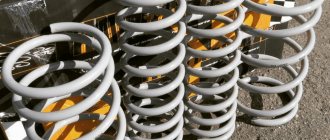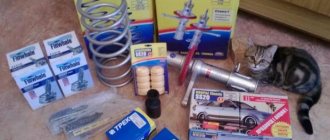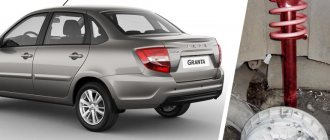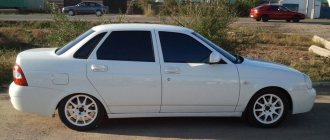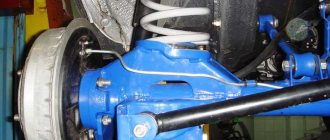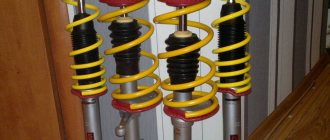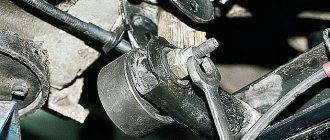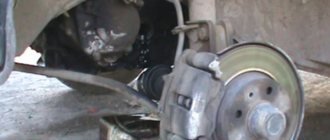Symptoms:
often breaks through the rear suspension.
Possible cause: the rear suspension shock absorber strut is damaged.
Tools: set of sockets, set of wrenches, socket wrench “22”, open-end wrench “6”, couplers.
1. Open the trunk.
2. Unscrew and remove the upper mounting nut of the shock absorber using a 22mm spanner; Be sure to keep the shock absorber rod from turning, for which use a “6” open-end wrench.
3. Raise the rear of the vehicle.
4. Unscrew and remove the lower shock absorber mounting nut, and then remove the bolt.
5. Remove the lower part of the shock absorber from the bracket, then remove the shock absorber assembly with its spring.
6. Remove the support washer (from inside the trunk).
7. Remove the upper cushion of the shock absorber strut from the hole in the support.
8. Remove the spring from the shock absorber.
9. Remove the bushing along with the lower cushion from the shock absorber rod.
10. Remove the housing from the shock absorber rod.
11. Remove the compression stroke buffer from the shock rod.
12. Inspect the rubber-metal bushing of the lower shock absorber mounting for defects. If any are found, replace the bushing.
13. Check the firmness and elasticity characteristics of the pillows, and also inspect them for damage.
14. Inspect the housing for tears or cracks, then check the compression stroke buffer. If there is damage, replace the buffer together with its casing.
15. Check the shock absorber spring insulation gasket. It should be resilient and elastic, and also should not have various defects.
16. Inspect the shock absorber spring. It should not have chips, cracks or other signs of destruction. Check the spring settlement by compressing it until the coils touch three times, and then applying a load equal to 3187 N. The length of the spring under the previously specified load must be at least 233 millimeters.
Note. Compression should be carried out along its axis. The supporting surfaces must match the surfaces of the shock absorber and body support cups.
Replace the shock absorber springs as a set (one spring for each rear shock absorber strut), as there is a possibility of installing different groups of springs, which, in turn, will cause different damping effects on both sides of the rear of the car.
17. Reassemble the shock absorber strut in the reverse order of disassembly. When installing the cover onto the casing, thread it onto the flange located on the cover.
18. Install the spring insulating gasket so that the end of the spring rests on the protrusion located on the gasket.
Note. When installing the insulation pad, secure it to the spring with electrical tape. This will prevent the gasket from slipping off.
19. Install the shock absorber spring so that its lower end rests on the protrusion located on the lower cup.
20. Install the shock absorber in the reverse order of removal.
Note. The lower end of the shock absorber spring should be directed toward the wheel on both the left and right strut.
21. Finally tighten the upper and lower shock absorber mounting nuts with the vehicle parked on the ground. With the car on the ground, rock it several times using a lot of force. Tighten the lower shock absorber mounting nut to the beam with a torque of 68–84 N∙m, then tighten the upper shock absorber mounting nut with a torque of 51–63 N∙m.
22. Re-tighten these threaded connections to the required torques after 100 kilometers.
Other types of repairs for this vehicle:
The rear struts on the Priora, meaning high-quality factory ones, can last more than 200,000 km under normal operating conditions. Of course, not every car can boast of such mileage before replacing rear shock absorbers. If the racks no longer hold, and the back of your Priora begins to float, or its body is covered in oil (leaked), then they need to be replaced with new ones.
Each owner can replace these parts independently; the main thing is to have the necessary tools at hand. In this case, to perform this repair you will need:
- Open-end wrench 19 mm
- 19 mm head
- Ratchet handle or crank
- Hammer
- Penetrating lubricant
- Special key for holding the strut rod
Do-it-yourself replacement of rear struts on a Priora
So, first of all, when the car is still on wheels, we remove the plastic plugs from the pillar cups from the interior side. It is under them that the shock absorber mounts are located.
If you have a special wrench, then use it to unscrew the nut securing the strut from above, holding the rod from turning. If there is no device, then we hold the rod with improvised means.
Once the nut is free to rotate, you can move to the lower shock absorber mount. To do this, remove the rear wheel and apply penetrating lubricant to the threaded connections. We wait a few minutes and unscrew the nut securing the rack from below.
We knock out the bolt if it is soured using a hammer and a punch. When you have dealt with this, you need to completely unscrew the upper fastening nut.
Now you need to pry up the shock absorber and remove it from its seat in the rear beam using a pry bar.
Now you can remove the entire shock absorber assembly, as well as the spring of the Priora rear suspension.
Video review of replacing rear struts on a Priora
The report was prepared using the example of a car of the tenth family, but there will be no differences from the Priora. The price of new racks produced by SAAZ, which are factory-made, starts from 1000 rubles per piece. Springs can be bought for 1000 rubles, a set of 2 pieces.
Today, the Lada Priora car is one of the most popular models in Russia. This simple, laconic and at the same time elegant, dynamic car has gained widespread respect due to its practicality, endurance, and ease of use. The car, which appeared on the market back in the late nineties, more than once underwent serious reformations, which concerned both the appearance and its technical component, and to an even greater extent.
Racks, what are they and why are they needed?
The struts have a complex design, but the basis is a hollow piston system. The piston system is equipped with multiple parts that secure the racks to the car body, and inside it is filled with either gas-oil liquid or oil. The principle of operation of the struts is that the piston, when it starts to move, seems to break the impacts falling on it, reducing their force.
On the Priora, as on other cars, problems with struts are expressed in oil leakage, insufficient adhesion of the tires to the road surface, and deterioration in maneuverability. Another sign of problems with the rear strut is a sudden, sharp increase in braking distance. According to professionals, if it is necessary to replace one rear strut, then it is wiser to change both at once, since otherwise there may be a mismatch of parts, which will lead to a significant deterioration in the operation of the entire system and a decrease in the dynamics, maneuverability and controllability of the car.
Useful tips
Let's start with the fact that some owners decide to install VAZ2110 shock absorbers on the Priora to increase load capacity and improve handling. In fact, it is better to abandon such experiments and immediately purchase a kit for the VAZ 2170. With struts from the “ten”, the Priora becomes more rigid, but the handling deteriorates.
It is also not recommended to install KYB racks for the VAZ 2110 on the Priora. Such modification will require the purchase of collapsible glasses from Priora, installation of other supports, etc.
Of course, you can take the SS20 supports separately, but the best option would be the Priora SS20 front strut complete with bump stops, supports and other parts from the same manufacturer. As for the rear shock absorbers, it is also better to take all the parts in one set.
If we compare KYB and SS20, the second option involves several options for racks. On the one hand, this allows you to select shock absorbers for specific tasks, but Kayaba, presented in only one option, is still better in quality and works well in any conditions.
Types and characteristics of racks
- Oily. Their action is based on the force of hydraulic oil. As a rule, such devices are two-pipe, although sometimes single-pipe ones are also found, but they are less efficient and difficult to operate. Oil racks are easy to install and are wear-resistant and durable. The only disadvantage of this device is that it does not cool well, which ultimately leads to deformation. But with proper care of the car, deformation may not occur soon. But oil parts are cheaper than gas-oil parts.
- Gas-oil ones are in many ways similar to oil ones, but here we have a completely different type of liquid, which means a different operating principle. Here, a part called a gas boost regulates the oxygen pressure, replacing it with nitrogen, which sets the entire system in motion. Such racks are often presented in a single-pipe version, unlike oil single-pipe ones; gas-oil ones are good in everything. The most significant advantage of the system is good heat transfer. The downside is less wear resistance than oil struts, as well as high sensitivity to external factors of various properties.
Features of replacing racks
At the beginning of the two thousandth there was a stage of restyling, which took the car along reformist paths. Now the racks have become more reliable, and the power unit is more powerful. But nevertheless, professionals propose to improve the restyled version by replacing the struts, since then its performance will be significantly improved. Although over time, replacement of parts is necessary in any case.
Before you decide to replace parts, you should be 100% sure of this. You can check the working condition of the racks in a very simple, old-fashioned way. You'll have to rock the corner of the car a little. Now count the number of free jumps. If one, then the system is normal. If there is more than one, then urgent replacement of the racks is required, since the old ones can no longer cope with the task assigned to them.
DS4 4556555
Pressing the lamp, turn it all the way counterclockwise and remove the lamp from the socket.
Pressing the lamp, turn it all the way counterclockwise and remove the lamp from the socket. Pressing the lamp, turn it all the way counterclockwise and remove the lamp from the socket.
We install the new PY21W lamp in the reverse order. In this case, two protrusions, located asymmetrically relative to the axis of the lamp, must fit into the corresponding grooves of the socket.
We carry out the operations for replacing the remaining lamps in the same way. In addition to the black “ground” wire, each lamp socket is connected to other wires of different colors. In order not to confuse the lamp sockets when installing them, the corresponding wire colors are indicated on the lamp body.
Replacing Priora struts
- The first step is to remove all the existing nuts that secure the racks to the car. Usually craftsmen use a 22*13 key for this task; it is most suitable in this case.
- Now you should secure the car well in order to work safely.
- The next step is to remove the wheel bolts.
- Raise the car with a jack; without this it will be difficult to carry out such exquisite, painstaking work.
- Never forget about safety rules. In this case, it is necessary to remember that it is necessary to place additional support under the wheels of the car in order to exclude the possibility of it rolling away. The emphasis should be in the opposite direction to the lift.
Once the bolt is removed, you can easily pull out the stand itself. The most important thing here now is to understand the cause of the breakdown and be able to fix it. It is necessary to carefully inspect the strut and spring, looking for deformations. Deformed parts must be replaced. Most often, bushings and anthers become faulty, while the bump stop, on the contrary, lasts longer than other parts, since it has a stronger design. Also, sometimes the corrugation casing becomes unusable, but it is easily replaced.
Not only the comfort of the driver and passengers of the car, but also their safety, as well as the performance of chassis parts, depends on the serviceability of the suspension elements. The basis of the rear suspension of the VAZ-2170 Priora and its modifications are shock absorber struts. The upper parts of the struts are attached to the car body (rear “cups”), the lower parts are attached to the brackets of the rear suspension beam.
When to change
Factory SAAZ rear struts usually withstand 70-80 thousand kilometers, after which, according to the factory’s recommendations, they need to be replaced. But there is no point in changing shock absorbers if they do their job perfectly, unless you want to change the characteristics of the suspension.
It is not difficult to determine the serviceability of the racks yourself. As already mentioned, the first sign of their malfunction is a visible oil leak. In addition, faulty shock absorbers give themselves away with a characteristic dull knock in the area of the rear arches. This is also evidence of their depressurization and oil leakage.
You can verify that the racks are faulty in a simple way. Try rocking the left or right rear of the car. If it swung once and froze rigidly, it means that everything is in order with the shock absorber from which you rocked the body. If the car continues to rock, the shock absorber is faulty, and the body lowers and rises due to the spring.
Basic faults
Failures of a part of the Priora suspension can be judged by the following signs:
- Oil leaks under the wheels. The shock absorber consists of a cylinder, valves, a piston with a rod - all parts actively move, so they need lubrication. If there are leaks, it means the device has become depressurized and will work less efficiently.
- Mechanical damage. If possible, visually inspect the parts - if there is any deformation or rust, it means they have “worked their best.”
- Rock the front (and then the back) of the car in different directions - away from you, to the left, to the right. When you release the car, one or two vibrations are considered normal - it is “damped” by a normal shock absorber. If the car stops immediately, the part is jammed; if it continues to wobble, replace it.
- When traveling, the car begins to wobble, the braking distance increases, and when turning, the car wobbles greatly. Also, when driving over speed bumps, or ordinary potholes, broken shock absorbers do not dampen vibrations at all, that is, the car sways as if on waves, and a knock will be heard.
Service station employees check the suspension with a vibration stand or a special stand. The check goes down to small units - they can even tell you how long it will take to approximately replace them.
Which ones to choose and their price
Having decided to replace the rear struts, you will have to choose among today's abundance of original spare parts and their analogues on sale. You can, of course, not bother and buy stock oil shock absorbers from the SAAZ plant, exactly the same as those installed on the Priora on the assembly line.
Part numbers:
Their prices vary from 1200 to 1400 rubles (for one rack) .
If you want to change the characteristics of the suspension, namely make it softer or stiffer, you can purchase alternative struts. The most popular shock absorbers among Prior owners are SS20.
They are distinguished by high reliability, and in addition, a variety of designs that allow you to change the stiffness of the suspension. There are four modifications of SS20 for Priora on sale: “Comfort”, “Standard”, “Highway” and “Sport”, differing in rigidity in ascending order. The cost of a pair of such racks is about 3,700 rubles.
"Technology System" – SS20
As for foreign analogues, the best shock absorbers are Japanese products. They also differ in rigidity and size, which also allows you to adjust the ride height. You can buy such racks at a price of 2,700 rubles per piece.
Important: it is recommended to replace shock absorbers in pairs, i.e. if you change it, then change it on both sides of one axis!
Useful tips
Which front struts are best to install on a Kalina 1118 station wagon?
While replacing shock absorbers isn't the most difficult job, we recommend leaving it to the experts unless you're handy with wrenches and have tools like spring compressors. Whether you do the job yourself or have a professional do it for you, insist on replacing shock absorbers in pairs across the entire rear or front of the car. This ensures a constant level of damping across the axle. (An imbalance in damping characteristics from left to right exceeding 30% will result in NCT/MOT failure.)
When installing them, be aware that some shock absorbers are specifically designed for only one side of the car. When ordering new shock absorbers, you should know that there may be different types that will suit your vehicle. We also recommend that you never buy used shock absorbers.
Replacement
To replace the rear struts yourself, you do not need to go to a service station. This process can be done at home and will not take more than an hour.
Tools and tools you will need:
- jack;
- a “shoe” or an ordinary brick to block one of the wheels;
- wrenches at “6”, at “19”, at “22”;
- rust remover like WD-40;
- small mount.
Work order:
- Place the machine on level ground.
- Secure one of the front wheels with a “shoe” or brick.
- Open the luggage compartment lid, move the trim on one of the rear “glasses” at the place where the pillar is upper mounted.
- Using a wrench set to “22”, unscrew the nut securing the strut, holding the shock absorber rod with a wrench set to “6”.
- Using a jack, lift the car body from the side of the wheel where you plan to replace the strut.
- Having climbed under the car, unscrew the nut securing the lower part of the rack to the rear beam bracket with a “19” wrench.
- If the nut does not budge (soured), treat the threads around it with WD-40, let it penetrate the joint for about 20 minutes, then try again.
- When the nut is unscrewed, remove the bolt and remove the lower part of the shock absorber from the bracket. To simplify this process, you can use a small pry bar.
- Remove the shock absorber.
- Go to the trunk and remove the support washer and strut pad from where the upper part of the shock absorber is mounted.
- Remove the lower spring, cushion, bushing, boot and compression buffer from the shock absorber. If the boot, buffer, or shock absorber pads show signs of damage, they also need to be replaced.
- Carefully inspect the shock absorber spring. There should be no cracks, chips or other signs of destruction on it. If they are present, the spring must be replaced.
- Reassemble the new rack in reverse order.
- Install the new rack by first inserting its rod into the upper mount, and then securing the lower part into the bracket with a bolt.
- It is recommended to finally tighten all connections after the car body has been lowered, i.e. after you remove the jack.
- Upon completion of the work, rock the car body several times on the side where the rack was installed.
- After 100-150 km, tighten the shock absorber mounting nuts.
Front suspension problems and solutions
| Cause of malfunction | Remedy |
| The racks are faulty | Replace |
| The bolts securing the stabilizer bar to the body are loose. Either wear and tear on the pads or barbell | Tighten the fastening bolts, replace the pillows |
| The fastening of the upper support of the suspension strut to the body is loose | Tighten the nuts securing the upper suspension strut mount |
| Wear of the rubber element of the strut support | Replace the rubber element |
| Wear of silent blocks of suspension arms, braces or stabilizer bar struts | Replace silent blocks |
| Wear of the ball joint of the suspension arm | Replace the ball joint |
| Worn or broken suspension spring | Replace spring |
| Destruction of compression progress buffer | Replace buffer |
| Increased wheel imbalance | Balance the wheels |
| Wear or destruction of the rod seal; nicks, scuffs on the rod, damage to the chrome coating; shrinkage or damage to the strut housing O-ring (shock absorber reservoir) | Replace the telescopic stand |
| Leaking recoil valve or bypass valve; insufficient amount of fluid due to leakage; scoring on the cylinder and piston ring; wear or damage to the fluoroplastic layer of the guide bushing; recoil valve spring settlement; the presence of foreign impurities in the liquid | Replace the telescopic stand |
| Compression valve leaking; insufficient amount of fluid due to leakage; rod wear or damage to the fluoroplastic layer of the guide bushing; the presence of foreign impurities in the liquid; wear, deformation or destruction of compression valve discs | Replace the telescopic stand |
| Suspension spring wear | Replace the front suspension spring |
| The stand doesn't work | Replace the telescopic stand |
| Wear of the rubbing surfaces of the ball joint parts as a result of contamination caused by leaks or damage to the cover | Replace the ball joint |
| Different tire pressures | Set your tire pressure to normal |
| Violation of wheel alignment angles | Perform a wheel alignment |
| Destruction of the rubber element of one of the front suspension strut supports | Replace the rubber element of the front suspension strut support |
| Uneven elasticity of suspension springs | Replace the front suspension spring that has lost its elasticity |
| Significant difference in tire wear | Replace worn tires |
| Increased front wheel imbalance | Get your wheels balanced |
| Excessive acceleration with wheel slipping | Practice a more relaxed ride |
| Frequent use of wheel locking brakes | When braking, do not allow the wheels to lock |
| Wheel alignment angles are incorrect | Perform a wheel alignment |
| Vehicle overload | Don't overload the car |
| Increased speed when cornering | Practice a more relaxed ride |
| Extensive wear on ball joints of suspension arms and silent blocks | Repair the front suspension |
| Wheel imbalance | Get your wheels balanced |
Key words: front suspension of Lada Priora
Found an error? Select it and press Ctrl Enter..
Brief summary
As you can see, replacing the rear struts on a Priora is not particularly difficult. The main thing is to make the right choice and purchase shock absorbers that will last for many years, as well as diagnose them in a timely manner and prevent critical malfunctions.
Rear shock absorber and spring assembly
Shock absorbers for cars, which are located in the rear of the body, are designed to soften mechanical shocks or even completely absorb their impact on the body of the car. In any case, racks have a certain service life, so the day will come when they will no longer cope well with the task. Replacing rear struts on a Priora is not the worst problem you may encounter while operating your car.
Which struts are better: gas or oil, or maybe gas-oil
Which racks are better on a Priora
I’ll say right away, not for the sake of advertising, I have never seen a better one on a Priora than the SS-20. To understand which racks are better, or which ones are more suitable for you, you need to know their operating principle.
Gas - the internal filling is gas, very hard, you can’t just push them through with your hand, or if you put them on a car, you can’t just break through the suspension - but you’ll drive like a bucket.
Oil-filled - they are filled with oil, soft, and very often create force in only one direction. Installed on almost all cans from the factory. The suspension is soft and killable - if you hit a good bump, it won’t be difficult to break through the shock absorber until it clicks unpleasantly.
Gas-oil ones are an interesting option; they contain both gas and oil inside. When the strut reaches critical compression, the gas is activated, pushing the oil and with it the rod into the neutral position. That is, on critical bumps the gas will not allow the suspension to break through.
What shock absorbers are suitable for Priora
Replacing rear shock absorbers directly depends on the conditions in which the Lada Priora is used. When the device becomes unusable, both the driver and passengers feel it. Therefore, you will think about a possible malfunction of the racks even before you arrive at the service center and undergo special diagnostics. You can feel the deterioration of the shock absorbers on the road. Your Priora will become less stable when maneuvering while driving at high speed.
There is a simple way to diagnose shock absorbers. You will need to swing the corner of your car and count the number of free jumps. If there are more than one, then the rear struts need to be replaced quickly.
Here are the rear struts on the car
In each case, replacing shock absorbers is an individual process. Factory parts, also called oil parts, are more affordable than their gas brothers. But they have one feature associated with a small temperature range. In winter, oil-filled shock absorbers become stiff. Therefore, such parts are offered by specialists only for urban vehicles.
Gas-oil shock absorbers will cost much more, but this price will fully correspond to their manufacturability. You will feel their role in the cold. Simply put, you will not feel any changes when the car moves, but this will be a confirmation of the quality of the rack. It is generally accepted that imported spare parts are reliable and made of high-quality materials, which is why Priora is equipped with Kayaba and SS20 shock absorbers.
Replacing old struts with new ones of improved quality does not guarantee perfect suspension performance. After all, this unit consists of many elements, and only a general replacement of parts can restore comfort and convenience in the process of driving the Priora. In principle, there is nothing complicated about how to replace rear shock absorbers on a front-wheel drive car. Therefore, this information will be useful not only to Priora owners. Drivers of other VAZ models can also use the instructions below.
Rear strut replacement process
Replacing the rear shock absorber: procedure
Let's take a closer look at the stages of the work. Your first task will be to unscrew the nut that secures the struts to the body. To simplify this matter, it is better to use a special wrench with dimensions 22*13. It is this tool that is used to remove and install shock absorbers in Priora.
After this, you need to securely secure the car, remove the wheel bolts and jack up the car. Never forget to install a safety system in the form of additional support under the wheels of the car. It is important that the stop is installed in the opposite direction to the lift.
So, the preparatory process has been completed, this guarantees fast and safe work on replacing each rear strut. Now you have to remove the rear wheel, remove the lower strut mounting bolt and pull it out. Most likely, this process will involve working with a hammer. After this, the faulty strut must be removed from the car along with the spring. The main thing is to correctly identify all faulty rack elements and replace them with new ones.
Very often the anthers and bushings become unusable. And, for example, a bump stop can last a long time, so you need to pay attention to its condition. Replacing the bellows casing is very simple. It is necessary to install the correct size fender washer on top of this element and place a new or old fender in the corrugation. The boot should be put on the rod, on top of which you need to place a donut-shaped rubber element with an iron bushing.
There is a rubber cushion on the shock absorber spring, which also needs to be removed from the body and checked for suitability. The spring should be correctly oriented and installed on the shock absorber, after which the new struts are ready for installation on the Priora.
The shock absorber is installed with its upper part into the body, and you need to ensure that the rod fits into the hole provided for it. Then the lower part starts. Everything is fixed with bolts and nuts. The lower connection of the rack must be firmly pressed against the beam itself, using keys.
Actions on the upper mount are carried out after the car body has been lowered slightly. This is necessary so that the spring is compressed under the pressure of the total weight of the machine. Assemble a pyramid from a donut-shaped rubber element and a washer and screw the nut onto the rod. Moreover, the rod must be kept motionless, holding it with a key. Tighten the mounting nut securely. After the upper part of the rack support has been assembled and installed, you can install the wheel in its rightful place and lower the Priora from the jack.
Removing the shock absorber and spring of the rear suspension of Lada Priora (VAZ-2170)
We remove the shock absorber for replacement when it loses its working properties, as well as when replacing a spring or failed rubber pads for attaching the shock absorber or compression stroke buffer.
To ensure that the performance characteristics of the left and right shock absorbers do not differ, both shock absorbers should be replaced. It is also necessary to replace the springs in pairs. Removal is shown on the left shock absorber, the right shock absorber is removed in the same way.
Inside the car, we recline the back of the rear seat and move the carpet away from the socket of the upper shock absorber mounting to the body.
Using a 17mm z-shaped wrench, unscrew the nut of the upper shock absorber mounting, holding the shock absorber rod from turning with a special wrench with a 6 mm wide slot. Remove the spring washer from the shock absorber rod...
...a support washer and an upper rubber pad.
From the bottom of the car, using a 19mm wrench, unscrew the nut of the bolt of the lower shock absorber mounting to the beam arm bracket, holding the bolt from turning with a spanner of the same size. We hang out the back of the car.
We take out the bolt (if there is difficulty, knock out the bolt with a soft metal drift). We remove the shock absorber from the eye of the lever bracket...
...and remove the shock absorber along with the spring. The spring gasket usually sticks to the body, from where it must be removed and ensure that there are no deformations or tears.
Remove the spring gasket.
Remove the spring from the shock absorber.
Remove the spacer sleeve with the lower cushion from the shock absorber rod... ...the cover with the cup and the compression stroke buffer.
If there is damage to the cushions, cover or buffer, replace them with new ones.
We assemble and install the shock absorber and spring in the reverse order.
For ease of assembly, we recommend attaching the gasket to the spring with adhesive tape or insulating tape. In this case, the end of the spring coil should rest against the protrusion of the gasket.
When installing the shock absorber rod cup, the flange of the 1st cup should fit into the recess 2 of the boot.
We put the compression stroke buffer on the shock absorber rod so that the buffer grooves are located at the bottom.
The end of the lower coil of the spring should rest against the protrusion of the lower shock absorber support cup.
When installing the shock absorber, we install it so that the shoulder of the support cup with a smaller height (shown by the arrow) faces the wheel, while the end of the lower coil of the spring on the left side of the car will be directed towards the rear of the car, and on the right side - towards the front.
To facilitate installation, you can put a piece of plastic tube (with an outer diameter of no more than 14 mm) on the threaded section of the rod... ...which will allow you to direct the rod into the hole in the upper spring support cup on the body.
We secure the lower end of the shock absorber, but do not tighten the bolt nut.
Using a jack to lower the car onto a wheel...
... using a tube, insert the tip of the shock absorber rod into the hole in the body. Having removed the plastic tube from the shock absorber rod, install the upper rubber cushion and support washer (convex downward) on the rod and secure the upper end of the shock absorber.
The nut of the shock absorber lower mounting bolt is finally tightened to the prescribed torque in the “car on wheels” position.

